Basics of screenwriting. A step-by-step guide, from concept to finished script. In this book, Syd Field gives guidelines for what he has learned throughout her career in order to develop a successful film script. It is one of the basic manuals that every screenwriter has had to read at some point. After reading it several times, I decided to take notes so I wouldn’t have to reread it in its entirety over and over again, and be able to get straight to the point. Whether you already read it or have it pending, I hope this summary will help you.
WHAT IS A SCRIPT?
A story told in pictures. Here we talk about the basic linear structure or the famous Paradigm of Syd Field. Where it is divided into:
- The Beginning or 1st Act, where you have to tell who the main character is and what the story is about. At the end of the first act there is a PLOT KNOT. ALSO CALLED turning point that makes the story go in another direction which would be…
- The Confrontation or 2nd Act which is the essential part of the film where the main conflict takes place. Where the character is dedicated to solving problems to achieve his goal until he reaches a crossroads that would mean another Knot or Turning Point that would take us to the last part that would be…
- The Resolution or 3rd Act. Where all the problems created throughout the plot are resolved. This would be the scheme
As a general rule, this scheme works in each and every one of the stories, although sometimes there may be more acts, it could be simplified into Beginning, Middle and End. You are born, you live and you die.
THE TOPIC
You have to know what your story is about and sometimes it’s hard to discern. However, it is vital to be able to develop your script correctly.
What kind of story is he writing? Is it an outdoor adventure script or is it more emotional and introspective?
The topic could be summed up as
The story is about this character in such a place doing this thing.
For example in toy story
Woody, Andy’s favorite toy, is relegated to the background when Buzz Lightyear, a space hero, appears. Woddy’s jealousy makes them both get lost in the city and they will have to iron out their rivalry to get back home.
The theme is usually defined through the action and the characters.
The action can be physical or emotional, and the characters have to define their needs and their actions. SCHEME
It all comes down to knowing the subject. If you know what the action and character are in the script, you can define the character’s need and then create obstacles to fulfilling that need.
Knowing the character’s need provides a goal, a destination, and an ending for the story.
Going back to Toy, the action would be to first get lost in the city
And the character Woody, a jealous toy who wants to go home to be with Andy. Once this is known, physical obstacles are added, such as the distance that separates them, but also emotional ones, such as when Buzz discovers that he is a toy.
CHARACTER
It is the basis of the script. You have to know the character to be able to develop the story. Syd Field emphasizes that there is only one protagonist (except on rare occasions) For example in Toy story The protagonist is Woody despite the fact that Buz also has a lot of weight, it is woody who plans everything and who carries the weight of the action.
When it comes to characterizing the characters there are several possible approaches. To start, you have to determine the inner world that would be from the birth of the character until the moment the film begins. To achieve this you have to answer several questions that only you can know: where is it from? In what time does he live, how was his childhood?
And on the other hand the external life. It is the one that develops throughout the feature film, it is the process that reveals who the character is.
This is done through his relationship with other characters, of which three types of interaction stand out.
- Conflicts to satisfy the need. Woody needs to get home. How he gets it and what he does for it.
- They interact with other characters that can be friendly, enmity or indifference. Here it should be noted that it is often easier to define evil characters because they generate more conflict. So precious in script.
- How do they interact with themselves? Overcoming your fears. It is an emotional resource for which we must define a fear.
To get deep characters you have to develop their three basic components:
- Professional. He works in an office or is a waiter at night. He is a high position, he gets along well with his colleagues
- Staff. He is single, widowed, has many friends or is introverted…
- Private. It’s what he does when he’s all alone. Here you can develop more intimate and dark facets.
Along with all this, it is necessary to define the need of the protagonist as already mentioned. This will cause him to create obstacles to achieve it. SCHEME:
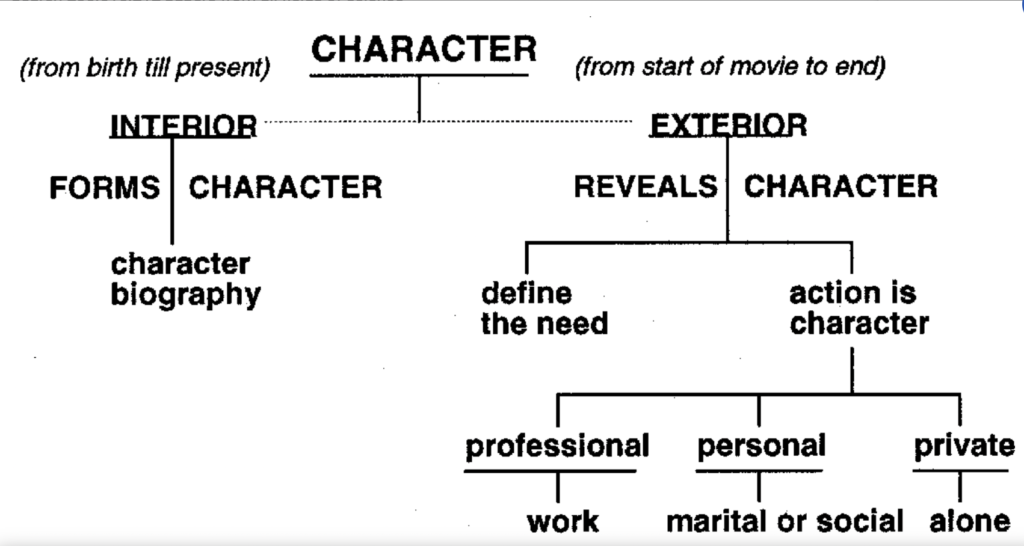
Dialogue is something that the more the inner world is worked on, the easier it will flow. Dialogues should convey information that moves the plot forward. To avoid clumsy dialogues it is essential to know our character.
BUILDING A CHARACTER FOR YOUR SCRIPT
Here we differentiate between Context and content. The first thing to do is define the need, the second is to prepare the biography in order to develop the three basic elements (professional, personal and private)
Once you have done this we will have the context and we will be able to go to the content or Point of view. All humans are the same. but the point of view is what makes us unique.
And this is expressed through attitude. If the character sees the world in a positive way, her attitude will reflect it with a more optimistic behavior. All this will help to configure a personality. If his attitude is positive, his personality will surely be more cheerful, but he may be clumsy.
Character is also conduct. His actions are what show us how that character really is. Imagine a person gets out of a rolls-royce to the nines and finds a 10-cent coin on the ground and bends down to pick it up after having checked that no one was looking at him. This can tell us a lot about the character.
Another important point is the Revelation.
We need to discover aspects about the character. at the same time as the character through the development of small actions that advance the plot. This encourages empathy or identification of the character. If the protagonist discovers that he is adopted or that he has been fired, he will make us feel identified or meet someone who has gone through something similar.
And all this has to be developed through ACTION. A character is what he does, not what he says.
THE CREATION OF A CHARACTER
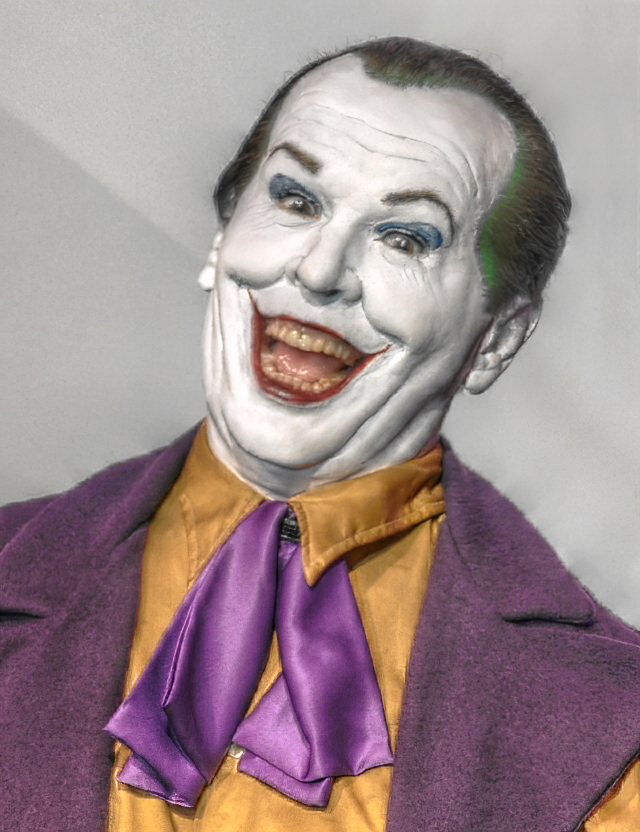
There are two models of approaching a script.
Have an idea and build appropriate characters.
Or on the contrary, create a character, and as a result of its necessity, develop a story.
To create a character you have to ask yourself a series of basic questions. From the general to the specific. Is she a woman? How old is she? Where is she from? We would continue with somewhat more specific questions such as what do her parents do, if she has one? How was her childhood or maybe she is living it…
The important thing here is not to take it too seriously. We can always change some aspects or everything if we see that it does not work, but all these questions must be answered.
Once this is done you will have the context. Now you will have to go to the outside world, to the content, remember? Professional, personal and private.
Once you have answered most of these questions you will have to start searching by trial and error for a topic. (Remember that the theme is the action plus the character). This dramatic theme or premise will move our character forward with actions.
If you have answered the questions, you have surely already found a need or an objective of the character. Once this is done you have to create an opposing point of view, in this way you can put obstacles to generate conflict and you will get the story.
SYD emphasizes that if you don’t know how to end the story, it’s always better to think of a happy ending. Alluding to the great Hollywood successes that usually have a happy ending but this is more a commercial point of view and not so much to configure a good script.
ENDINGS AND BEGINNINGS
Alluding to the paradigm, a story progresses from approach to resolution. A progression of related events.
The story progresses from the beginning to the end. You have 10 pages to make it clear who the protagonist is, what the dramatic premise is or what the story is about, and the circumstances surrounding the story.
And to do this it is necessary to know the End of the story. You don’t have to know the specifics, but you do have to know what’s going on. Avoid open endings or excuses as my character decides the ending for her. Loose ends must be tied up, all questions raised must be answered.
Think that an end can always be a beginning and a beginning can be an end. You choose which fragment of someone’s life you are going to tell.
THE APPROACH
This chapter reiterates the importance of the first 10 pages by making an exhaustive analysis of the chinatown script. In short, idyllically, an approach to the story must be achieved by presenting and characterizing the protagonist in a visual way.
Many good scripts often take time to raise all these things and even after a first reading after understanding the whole, the second reading turns the script into a formidable story.
But no one is going to read the script twice except you.
The goal here is to get a clear idea of what the film is about and who the character is in the first 10 minutes. Where you have to expose the approach of the whole story.
In many production companies if after reading the first 10 pages they do not know who the protagonist is, what the dramatic premise is or what the story is about. They may not continue with him.
SEQUENCE IN THE SCRIPT

A script is like a system. The sequence is the skeleton, the base on which everything is structured.
They have a beginning, a middle and an end. It’s a mini story inside the story.
First you have to choose a context and content.
Like when Buzz gets into what he thinks is a spaceship to take him back to his destination. while woody trying to find a way home, he follows him to convince him that they have to get out of there.
From here you have to create content. which would be divided initially. Buzz’s arrival on the spaceship. They all welcome him enthusiastically and explain that the hook is the one in charge. Then we set up the scene where Buzz, oblivious to the fact that it’s a toy machine, has to be hidden by Woody to stay out of the reach of the hook. Woody finds a back door and manages to open it, he can escape, but buzz has been caught by the hook.
This is where the turning point that triggers the ending would occur, Woody is able to escape, but he needs to get back to Buzz to be accepted by the rest of the toys, so he finally allows himself to be captured by the devilish neighbor.
This is a perfect example of a sequence where, through a beginning, a small development and an end, they tell us the theme of the entire film.
A good script according to field is the one that is made based on 4 sequences that would be the beginning, the knots of the plot and the end, and uniting them through well-linked sequences that move the action forward.
THE KNOT OF THE PLOT
When writing a script it is difficult to have an overview. You have to know where you are going, have an address. Hence the importance of the paradigm, it is a map but when you are in the paradigm you cannot see it clearly. For that we need the plot point, which is something, an incident or an event that turns the action in another direction. It’s what moves the plot forward. Plot knots also called turning points at the end of the first and second acts. They are the ones that make up the basis of the paradigm and they need to be clear before writing the script along with the beginning and the end.
But these are not the only ones. There may be several that move the plot forward.
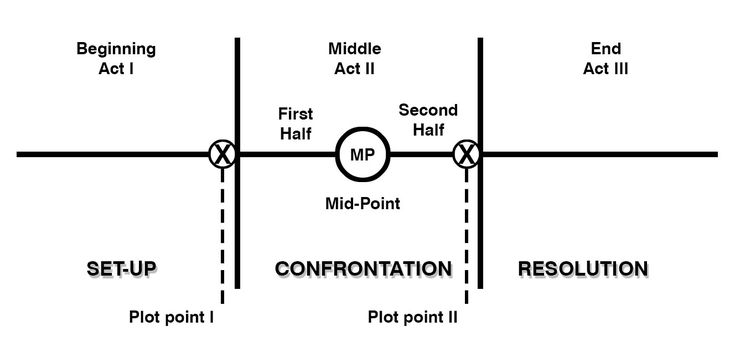
In the three days of the condor. Robert Redford discovers a conspiracy within the CIA where he works. When he returns from buying food for his team he finds them all dead. It takes him a while to understand the situation, he is only alive by the luck of having gone out for lunch, then he realizes that sooner or later they will end up going for him. Finding his dead companions is the plot point or turning point at the end of the first act. From here he has to find out who and why they want to kill him.
The second act is the confrontation, he fails to find out anything and he is chased by an assassin until he is forced to do something and kidnaps the person in charge of the condor operation that redford had uncovered. This would be the 2 Knot where Reford passes from attacking victim, getting the information he needed. There is a CIA within the CIA to cover the exploitation of some oil fields.
THE SCENE
It is a specific unit of action within a space in which the story is told. It is one of the most important parts of a movie. When you remember a movie, you don’t remember the entire movie but its most emblematic scenes.
The purpose of the cutscene is just like the sequence to move the story forward.
Every scene has two components. PLACE and TIME. And so it is reflected in the header of each scene in a script. EXT FARMHOUSE – DAY
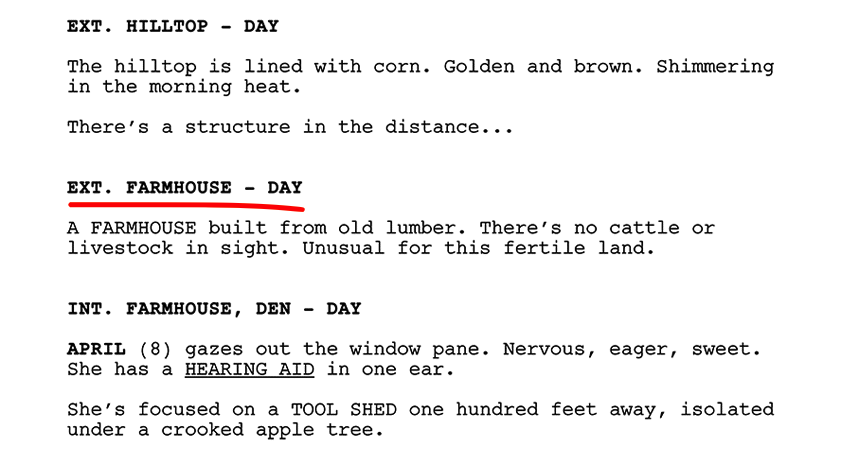
The scene has to reveal a fact about the story. There are action scenes where there will always be a minimum of dialogue and vice versa.
Field determines in his experience some tips like making dialogue scenes that take up less than three pages, or avoiding flashbacks if you can solve it in the present. And it is that except for exceptions where you can be especially creative, these resources do not usually work.
To create a scene, first create the context and then the content.
try to ask yourself:
What happens, what is the purpose and how does it advance the story? What personal or private professional aspect of the character will be revealed?
For example, imagine that two people want to rob a bank so far they have only joked about it but now they are going to make the decision to do it. First we must develop the content. Where are they going to do it? The logical thing would be to do it in a remote place where they would have privacy, but the logical thing is sometimes predictable and undramatic. When developing a scene, it is convenient to use the least obvious and most visual way of showing it.
Generating counterpoints or ways to add suspense make scenes more powerful. Hitchcock did this constantly. Imagine that the protagonists are finally going to discuss the robbery playing pool and while they develop the details a policeman enters the premises. You are generating tension and suspense. They will be able to speak clearly without concern or they will have to speak using metaphors? Complications are essential when developing scenes.
By creating the context (purpose, place and time) the content follows naturally. First look for the purpose then place it in space and time and finally add the elements generating the components or conflicts that make it work.
THE ADAPTATION (Script)
Field recommends treating adaptations like an original script while keeping the essence of the story to be adapted. The most common adaptation is that of the novel whose main difference with a script is that its world takes place inside the heads of the characters. In the theater it is narrated through the words with dialogues that expose the thoughts of the characters. A script is a story told in images.
Adapting does not require being faithful to the source material, this is the starting point but you may have to add characters, scenes or incidents to make it visual and to be able to tell it with images. It must be faithful to the integrity of the work, its essence.
THE FORM OF THE SCRIPT
Here the emphasis is on the format per se of the script. And the need to know if you want to be taken seriously in the industry. If you write a script and you are not using the correct format, not a single page will be read even if you have the best story in the world.
THE CONSTRUCTION OF THE SCRIPT
Once the beginning, the two turning points and the end have been determined. We just have to fill in the rest. What it would be like to develop the beginning, the middle and the end or each one of the 3 acts but knowing where they come from and where they are going.
One of the main characteristics to develop a successful script is to endow the character with a need and once determined to put obstacles and that this takes actions to achieve it. Here he highlights the difference between a personage that acts. It makes things happen or a character that reacts. Things happen to you. The essence of the character is the action must act not react.
To develop the acts, Field recommends using index cards (like this one) for each sequence. And develop as many as necessary until the story is complete. There is no magic number, simply let your story take you but keeping in mind that each action corresponds to a reaction of equal intensity and meaning. Another way is to develop a treatment or narrative synopsis where everything that happens in the sequences is summarized to later detail it with dialogues and specific scenes.
SCREENPLAY WRITING
The hardest thing about writing is knowing what to write, but once you have completed all the steps and have all the parts of the paradigm you will have the structure of the script. Now write. Field emphasizes the importance of reserving a space for full concentration and establishing a fixed schedule. But this is something very personal that can vary depending on your preferences. What does stand out above all else is the perseverance from day to day.
It is a long-distance race and self-boycotts will arise to stop writing. One of the most common is finding a better idea to abandon the project you’re on. But if you decided to start the new story, you would realize that the same thing would happen to you over time and you would never finish any script.
It is a complex process, one day you are animated and everything flows well and the next day it is lost and nothing makes sense.
ABOUT COLLABORATIONS
Many of the best scripts have been written thanks to the collaboration of several people and on TV there are always teams of writers collaborating. In the collaboration process, it is advisable to establish 3 stages: 1 Establish the rules 2 The necessary preparation 3 The writing itself.
There will always be ego fights, even the most humble person will want to make his idea prevail over the other. It’s okay to set a set of rules. Who is going to do what? There are always people who are better at creating characters and others the action or maybe one gathers information and the other organizes it…
Another method is to work by units. One writes 15 or 20 pages and then the other corrects it and writes another few pages and so on. It doesn’t matter if you write with a partner with your best friend or his partner. Establish ground rules, preparation, and mechanics for writing.
WHEN THE SCRIPT IS ALREADY WRITTEN
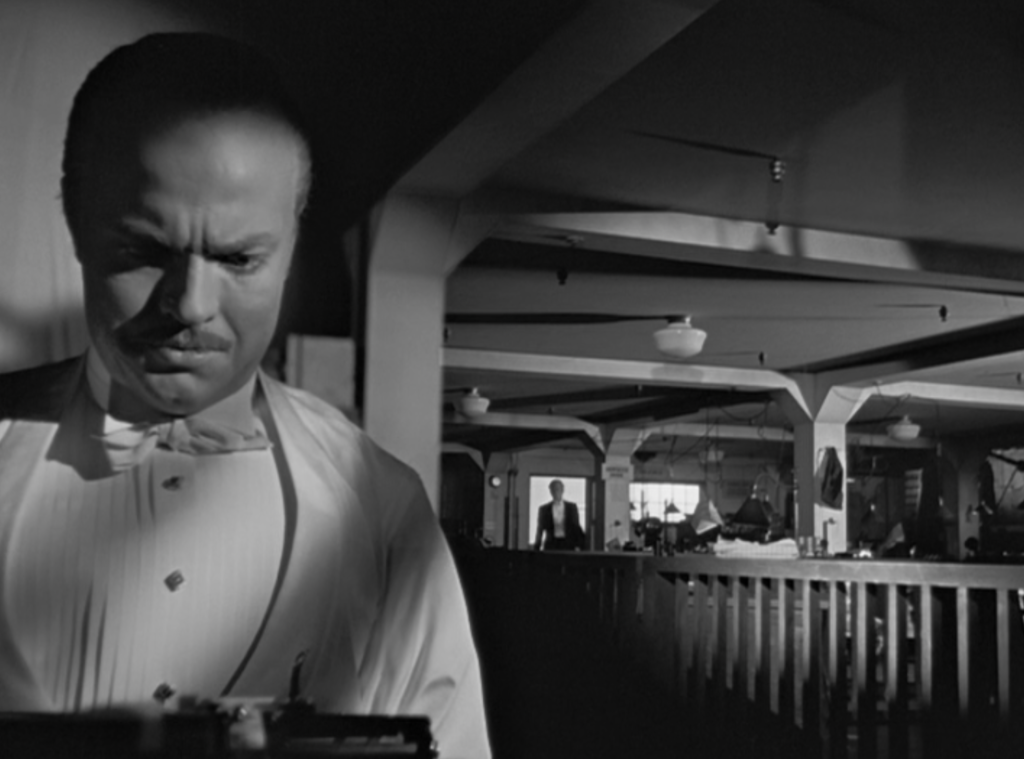
Once the script is already written, it needs an external observation. Get away from him. You cannot, it is impossible, you have been fully involved in that script and you are unable to see it objectively, it is as if it were your son. You need someone to give you their honest opinion. If you are lucky enough to have a friend or family member who can give you their honest opinion, it could be very helpful.
Although in these cases the best thing you can do if you have a budget is to consult an analyst who will tell you carefully all the shortcomings and strengths of the script. Flat characters, showy dialogues or unresolved plots….
Once this is done, it is convenient to register the script Depending on the country you are in, the process will be different. Once registered, you can send the script to the producers. Today production companies often do not accept scripts from people they do not know, so you will have to prepare a small dossier telling in the most attractive way possible what your script is about… And hopefully.
PERSONAL NOTE
Remember why you decided to write your script. You will find many people who give you their opinion without asking for it and a thousand ways to improve it. Everyone is a writer but no one writes. Nothing replaces perseverance. The writing process is an art that is enjoyed. It doesn’t matter if it’s good or bad, having completed a script is already a feat, feel proud.
And here is the summary. I hope you have found it useful.
